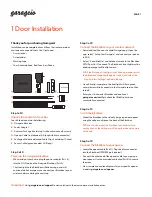
RAIDER
2000
-
13
-
OPERATOR FOR SWING GATES
English
SAFETY STANDARDS AND INSTALLER OBLIGATIONS
Installers must proceed as follows to conform with safety standards:
• wear protective clothing (accident-prevention footwear, goggles, gloves and helmet);
• do NOT wear clothing or jewellery that may become trapped (ties, bracelets, necklaces, etc).
A motorised gate is a machine and as such must be installed in accordance with health and safety standards
and legislation.
Before installation a risk analysis for the installation site must be performed by professionally quali
fi
ed personnel
in accordance with current legislation for motorised gates (refer to EN 12453 and EN 12445). In countries outside
the EU refer to national regulations and legislation as well as the standards speci
fi
ed.
• Only professionally quali
fi
ed personnel should install the product.
• Installation, electrical connections and settings must conform with current legislation.
• Carefully read the instruction manual before installation.
• Incorrect installation may be a source of hazards.
• Packaging must be disposed of in accordance with current legislation. Do NOT litter the environment.
• Check that the product and packaging are undamaged before starting installation.
• Do NOT install the product in areas where there is a risk of explosion. Gas, powders and
fl
ammable fumes represent a
health hazard.
• Check that all safety measures are taken and that people are protected from areas posing a risk of crushing, cutting,
trapping and any other hazard, in accordance with current legislation for motorised gates.
• The installation area must be cordoned off to prevent access by unauthorised personnel.
• Protection devices must be installed following risk analysis of the site. Check that the protection devices are marked and
that they function in accordance with current legislation.
• The data required by applicable legislation must be clearly visible on the installation.
• Check that the mains power available is compatible with the data on the identi
fi
cation plate before connecting the operator
to the mains power supply.
A suitable differential overload switch must be installed upstream of the operator.
• The manufacturer of the operator declines all responsibility if components are used which are incompatible with correct
and safe use.
• The installer must provide the user with all the information need to operate the device with particular attention given to
manual operation in the event of an emergency and any residual risks.
WARNINGS FOR THE USER
• The instructions and warnings given below are a vital and integral part of the product. The instructions and warnings
must be given to the user and then read carefully because they include important warnings for use and maintenance. The
instructions must be kept and given to all future users.
• The operator must be used exclusively for the purpose for which it is designed. All improper use is forbidden and
hazardous.
• Keep away from moving mechanical parts. Keep away from the operating range of the device during operation. Do not
try to obstruct the movement of the device as such action may be hazardous.
• Keep children away from the operating range of the device at all times.
• Keep remote control and other control units in a safe place to prevent use by children or unauthorised people.
• In the event of any faults disconnect the operator from the mains power supply using the main switch. Do not try to repair
the main unit. Contact the installer or other specialist assistance centre. Failure to follow these instructions may result in
hazardous situations.
• All maintenance, including cleaning, must be performed by quali
fi
ed personnel.
• Follow the manufacturer’s instructions and refer to specialist personnel to perform routine maintenance, particularly
veri
fi
cation of correct functioning of protection devices, to ensure correct and ef
fi
cient functioning of the operator.
• All repairs and maintenance must be recorded on the maintenance record and then made available to the user.














































